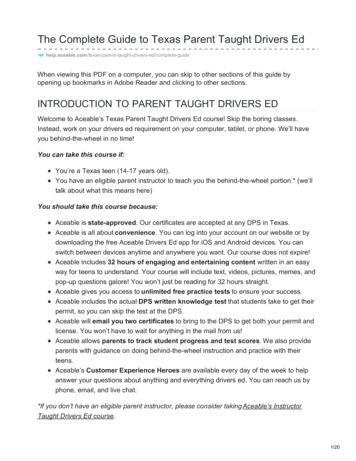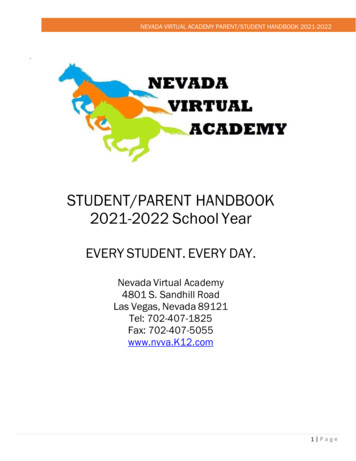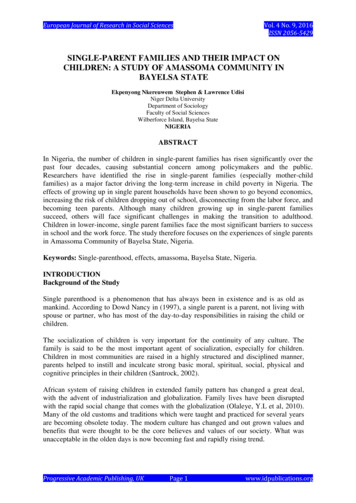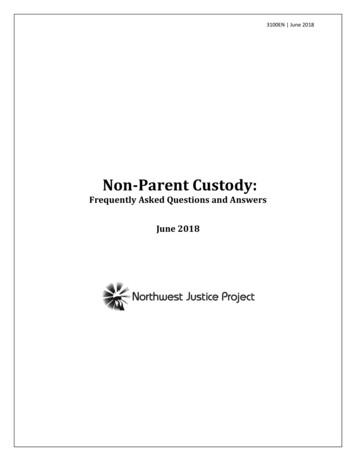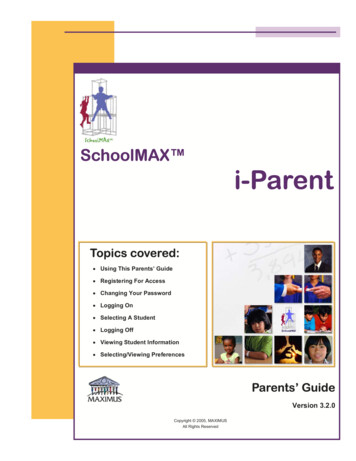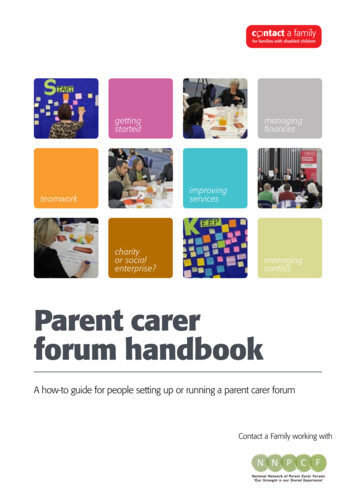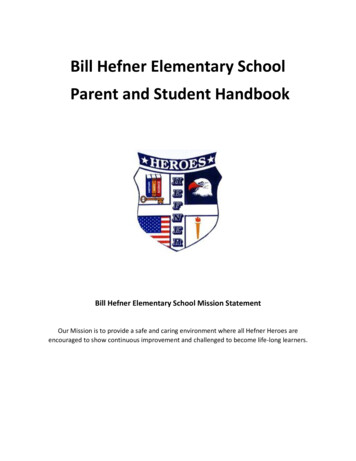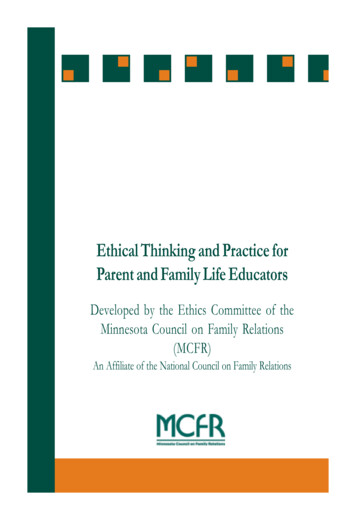
Transcription
Parent & FamilyHandbookOffice of Student Affairs2021–22
Note: Some office hours, contact information, and resources arelikely to change throughout the year. Please check saic.edu for thelatest information.Table of ContentsAbout SAICContemporary Practices 2020–20215A History of Innovation14 Course Descriptions and Structures5SAIC TodayProgram Descriptions and CurricularRequirementsDegree Programs6Degree Tracks6Public ProgramsSupporting Your Student15 Bachelor of Fine Arts in Studio15 Bachelor of Arts in Art History16 Bachelor of Arts in Visual and Critical Studies16 Bachelor of Fine Arts with an Emphasis inArt Education7Your Role7Parents Web Page7Parents News16 Bachelor of Fine Arts with an Emphasisin Writing7Parents Facebook GroupOther Academic Programs7SAIC Parent Email16 Academic Access Program7Family Weekend17 English for International StudentsFERPA, Records, and Family Notification PolicyOff-Campus Study817 IntroductionFamily Educational Rights and PrivacyAct (FERPA)17 SAIC InternshipsAcademic ExperienceCampus Resources11IntroductionNavigating Campus11No Letter Grades?18 Student ID Card: ARTICard12 Instructor Check-ins18 Transportation at SAIC: CTA Ventra U-Pass12 Critique18 Food Service at SAICPARENT HANDBOOK2
Important SAIC Publications19 SAIC Bulletin19 Degree Course Schedule19 Student Handbook19 School of the Art Institute of Chicago magazine19 F NewsmagazineAcademic Resources20 Office of the Dean of Faculty20 Academic Advising20 Korean and Chinese Advising21 Writing CenterLibraries and Special Collections21 John M. Flaxman Library22 Special Collections at the Flaxman Library23 SAIC Digital Collections23 Additional Campus CollectionsTechnology, Media Centers, andShops on Campus31 Introduction31 Technology Fee31 Laptop Requirement31 Computer Labs32 Online Community and Resources32 Printing and Output Services33 Media Centers33 280 Building Wood and Metal ShopsThe Wellness Center33 Health Services33 Health Insurance34 Immunization Policy36 Counseling Services36 Disability and Learning Resource CenterCareers in Art and DesignLife at SAIC24 Career and Professional Experience (CAPX)Where to Live25 Prepare and Connect37 Residence Life25 Internships38 Campus Security26 ResourcesA Multicultural Campus26 Programs and Events38 Academic Affairs27 Alumni Relations38 Multicultural AffairsFinancing Your Student’s Education39 Role of Multicultural Affairs28 Tuition Charges and Billing40 International Affairs28 Payments and Deadlines40 International Student Services28 Payment Plans40 Study Abroad29 Late Payments and HoldsLife Outside the Classroom/Studio29 Butler Loan41 SAIC and Chicago29 Grants, Scholarships, and Loans AwardedThrough the Student Financial Services Office41 The Art Institute of Chicago29 Financial Aid Tips for Students, Parents,and Families42 Libraries and Study CentersPARENT HANDBOOK3
Getting Involved at SAIC44 F Newsmagazine42 Campus Life44 Free Radio SAIC43 Student Groups45 SITE Galleries43 Student OrganizationsPublic Programs43 Student Government45 Exhibitions/Exhibition Studies43 Student Programming Board45 Gene Siskel Film Center44 ExTV46 Visiting ArtistsPARENT HANDBOOK4
About SAICA History of InnovationFounded as the Chicago Academy of Design in 1866, the School of the Art Institute of Chicago (SAIC)was started by 35 artists who intended to run a school with its own gallery and to provide a challengingeducation in the studio arts and exhibition opportunities for its students. It was incorporated as theChicago Academy of Fine Arts in 1879 and changed its name to the Art Institute of Chicago in 1882. Themuseum and school moved into the iconic building on Michigan Avenue, which was designed and builtfor the World’s Columbian Exposition of 1893.Since 1976, SAIC has occupied its own cutting-edge facilities adjoining the museum and its new ModernWing overlooking Millennium Park and Lake Michigan with additional buildings throughout an urbancampus in the heart of the Chicago Loop. Throughout the School’s history, alums have played a centralrole in important art movements. It was SAIC that provided the impetus for two significant schools ofAmerican painting, the Regionalists of the 1930s and the Imagists of the 1960s. Some of the most notablenames in the arts received their early training at SAIC, including Georgia O’Keeffe (SAIC 1905–06, HON1967), Claes Oldenburg (SAIC 1951–54), H.C. Westermann (SAIC 1947), Thomas Hart Benton (SAIC 1907–09), Grant Wood (SAIC 1913–16), Ivan Albright (SAIC 1920–23, HON 1977), Ed Paschke (BFA 1961, MFA 1970,HON 1990), Roger Brown (BFA 1968, MFA 1970), Halston (SAIC 1952), LeRoy Neiman (SAIC 1946–1950, HON2006), Elizabeth Murray (BFA 1962, HON 1992), Cynthia Rowley (BFA 1981), David Sedaris (BFA 1987), RirkritTiravanija (MFA 1986), and Sarah Vowell (MA 1999).SAIC Today: Art and Design in the 21st CenturySAIC is one of the largest accredited independent schools of art and design in the country. Providingdegrees at the undergraduate and graduate levels, the School has been recognized by U.S. News andWorld Report as the number two graduate art program in the nation, as well as by Columbia University’sNational Arts Journalism Survey as “the most influential art school in the United States.” SAIC offers abroad and dynamic spectrum of study including architecture; art and technology; arts administration;art history, theory, and criticism; art education; art therapy; designed objects; fashion design; film,video, new media, and animation; historic preservation; interior architecture; new arts journalism;painting and drawing; performance; photography; printmedia; sculpture; sound; visual communicationdesign; visual and critical studies; and writing. A comprehensive program in liberal arts emphasizes thecritical role that humanities, mathematics, and sciences play in artists’ development.To learn more, visit saic.edu.Degree ProgramsSAIC is composed of studio departments, a Contemporary Practices department, which combines skillbased instruction with conceptual exploration and research, and seven academic departments with anemphasis on interdisciplinary study. We offer undergraduate degrees and graduate degrees as well aspost-baccalaureate certificates and Continuing Studies programs.PARENT HANDBOOK5
Degree Tracks Include: Master of Fine Arts in Studio Master of Fine Arts in Writing Master of Arts in Arts Administration and Policy Master of Arts in Art Education Master of Arts in Art Therapy and Counseling Master of Arts in Modern and Contemporary Art History Dual Degree: Master of Arts in Modern and Contemporary Art History and Master of Arts in ArtsAdministration and Policy Master of Arts in Teaching Master of Arts in Visual and Critical Studies Master of Arts in New Arts Journalism Master of Science in Historic Preservation Master of Design in Designed Objects Master of Architecture Master of Architecture with an Emphasis in Interior Architecture Master of Design in Fashion, Body and Garment Post-Baccalaureate Certificate in Studio Post-Baccalaureate Certificate in Fashion, Body and Garment Bachelor of Fine Arts in Studio Bachelor of Arts in Visual and Critical Studies Bachelor of Fine Arts in Art History Bachelor of Fine Arts with an Emphasis in Art Education Bachelor of Fine Arts with an Emphasis in Writing Bachelor of Arts in Art HistoryPublic ProgramsStudents have access to a variety of public programs that play an important role in the life of theSAIC community. Our programs include: the Gene Siskel Film Center, which presents experimental,international, and documentary films throughout the year; the Video Data Bank, one of the world’sleading repositories of experimental videos, documentaries, and taped interviews with artists; theVisiting Artists Program, which brings a variety of artists, designers, performers, and lecturers to SAICeach year; SAIC Galleries, which present a full roster of special exhibitions, performances, and video andfilm screenings by students and other guest artists; and the SITE Galleries, two gallery spaces on campusthat are run by students with the help of a faculty advisor devoted to showing the work of students inexhibitions conceived and curated by students.Our other resources include the Roger Brown Study Collection, Fashion Resource Center, John M.Flaxman Library, Ryerson and Burnham Libraries, Joan Flasch Artists’ Book Collection, and of course,PARENT HANDBOOK6
the Art Institute of Chicago museum and its Modern Wing. The community your student has joinedprovides unmatched resources and excellent learning opportunities in an atmosphere designed to fosterartistic growth.Supporting Your StudentYour Role in Your Student’s EducationThe support of families and friends is beneficial to the ongoing academic and artistic success of SAICstudents. Your student may turn to you for advice, or they may ask you to attend Family Weekend, anart opening, or one of the numerous activities and events SAIC offers. We encourage you to becomeengaged in your student’s education. This handbook was designed to provide you with information aboutthe many SAIC resources available to you and your student.Parents Web Pagesaic.edu/parentsSAIC provides parents with helpful information regarding services, resources, forms, and more viathe web page at saic.edu/parents. A quick link to this web page is also available on SAIC’s home pageat saic.edu.Parent NewsSAIC also shares important information with parents via the Parent News. This newsletter keeps parentsupdated on what is happening across campus, and also provides important updates on the year ahead.Parent News is emailed quarterly. Parents interested in receiving SAIC’s Parent News can subscribeonline by clicking on the “Join the Parent eNewsletter” link at saic.edu/parents.Parents Facebook GroupJoin our School of the Art Institute of Chicago Parents Facebook group to keep up with important dates,events, and general SAIC information. This resource is also a great way to ask advice and opinions ofother SAIC parents and families.SAIC Parent EmailNot sure where to start? SAIC is happy to support parents and families any way it can. If you are notsure how best to support your student, or you need help providing assistance, just email SAIC atparents@saic.edu.Family Weekendsaic.edu/parentsFamily Weekend plans are still to be determined. Family weekend is typically held in mid-October. Formore information, please visit the parent’s website, or contact the Campus Life office.PARENT HANDBOOK7
Parent and Family Notification and Records PolicyA student’s family often serves as a valuable partner in helping the student be successful at SAIC.Students often find it helpful for SAIC staff to communicate with their family members directly. Forpurposes of this policy, the term family includes a student’s parents, guardians, emergency contacts, andother family members.The Federal Family Educational Rights and Privacy Act of 1974 (FERPA) is a Federal privacy law thatgives students certain rights with regard to their own education records, such as the right to inspectand review their own records. To protect a student’s privacy, the law generally requires schools to askfor written consent from the student before disclosing personally identifiable information from thatstudent’s records to others. To facilitate contact with a student’s family and supports, students arestrongly encouraged to sign the FERPA Student Authorization to Release Information Form (found ferpa) to identify specific family members or otherexternal supports with whom SAIC may share student-specific information. By completing and returningthis form, a student consents to SAIC’s disclosure of information from their student records to theperson designated on the form.FERPA does permit schools to disclose student information without consent under the followingcircumstances (referred to as exceptions).Directory Information: SAIC may disclose “directory information” without a student’s written consent.SAIC designates the following as “directory information”: Student name(s) Student address(es), electronic address(es) (email) and telephone number(s) Dates of admission/attendance Academic program Degrees and awards received Participation in officially recognized activities Previous institutions attended Date and place of birth Expected graduation date Hours enrolled and enrollment status (full-time, part-time, not enrolled, and/or withdrawn and dateof withdrawal)Hours enrolled and enrollment status (full-time, part-time, not enrolled, and/or withdrawn and date ofwithdrawal)If a student wishes to have their directory information withheld, they must submit a written request tothe Office of Registration and Records. Students may give such notice at any time, but it will only beeffective prospectively. Students must be currently enrolled to make this request.Dependent Status: If the student is a dependent of a parent or guardian for tax purposes, then SAICmay disclose information from that student’s education records to the parent or guardian of the student.Health and Safety Emergencies: SAIC reserves the right to notify a student’s family when it reasonablybelieves that there is a health or safety emergency. This includes, but is not limited to, hospitalizations,PARENT HANDBOOK8
hospital transports, serious physical or mental health conditions, situations in which a student is absentfrom campus for a prolonged period, situations in which a student is believed to be missing, or when, inSAIC’s judgment, the health or well-being of the student or others may be at risk.Change of Status: A change in student status may occur voluntarily or as a result of disciplinary action orunsatisfactory academic progress. A change in status may include a student being placed on probation,suspended, required to withdraw, or expelled. Enrollment Status: SAIC may notify a student’s family if they are placed on academic probation,academically suspended, dismissed, required to withdraw, or withdraw voluntarily. Student Conduct Status: SAIC may notify a student’s family in certain situations related to studentconduct concerns including, but not limited to: when the student is under 21 years old and found to have violated a law, rule, or policy governingthe use or possession of alcohol or a controlled substance; when the student is found in a student conduct proceeding to have committed a crime of violenceor nonforcible sex offence; when the student is placed on disciplinary probation, suspended, or dismissed from SAIC.Arrests: Arrest information is public information and is not considered part of a student’s educationalrecord. The family of the student may be notified if it comes to SAIC’s attention that a student hasbeen arrested.Legitimate Educational Interests: A student’s education record may be disclosed to school officialswith legitimate educational interests. A school official is a person employed by SAIC in an administrative,supervisory, academic, research, or support staff position (including law enforcement unit personneland health staff); a person serving on the board of governors or trustees; or a student serving on anofficial SAIC committee, such as a student conduct board meeting. A school official may also include avolunteer or contractor outside of SAIC who performs an institutional service or function for which SAICwould otherwise use its own employees and who is under the direct control of SAIC with respect tothe use and maintenance of personally identifiable information from education records, such as staff inCampus Security, facilities, or campus dining. It also includes attorneys, auditors, and collection agentsand students volunteering to assist another school official in performing their tasks. A school officialhas a legitimate educational interest if the official needs to review an education record in order to fulfillprofessional responsibilities for SAIC.Upon request, SAIC also discloses education records without consent to officials of another school inwhich a student seeks or intends to enroll.Notification of Rights Under FERPAThe Family Educational Rights and Privacy Act (FERPA) affords students certain rights with respect totheir education records. These rights include:1.The right to inspect and review education records within 45 days after the day SAIC receives arequest for access. Students should submit a written request that specifically identifies the record(s)they wish to inspect to the director of registration and records. The director of registration andrecords will make arrangements for access and notify the student of the time and place where therecords may be inspected. To make this request, students may use the FERPA Student Request forRecords Form, available from the director of registration and records.PARENT HANDBOOK9
2. The right to request the amendment of their education records if they believe them to beinaccurate. Students should submit any such request in writing to the director of registration andrecords. They must clearly identify the part of the record they want changed and specify whyit should be changed. SAIC will review the request and notify the student of its decision. If SAICdecides not to amend the record as requested, SAIC will notify the student of their right to a hearingregarding their request for amendment. Additional information regarding the hearing procedures willbe provided to the student at that time.3. The right to file a complaint with the US Department of Education concerning alleged failures by SAICto comply with the requirements of FERPA. The name and address of the office that administersFERPA is: Family Policy Compliance Office, US Department of Education, 400 Maryland Avenue, SW,Washington, DC 20202.4. The right to provide written consent before SAIC discloses personally identifiable information fromtheir education records, except to the extent that FERPA authorizes disclosure without consent.To provide written consent to a disclosure, students may use the FERPA Student Authorization to ReleaseInformation Form as described above.More information on the requirements of FERPA and other exceptions to FERPA is available on the FamilyPolicy Compliance Office’s FERPA webpage: ed.gov/policy/gen/guid/fpco/ferpa/index.html. Questionsregarding FERPA should be directed to the director of registration and records.PARENT HANDBOOK10
Academic ExperienceIntroductionWhat most distinguishes SAIC from other art and design schools is the breadth and depth of itscurriculum and the freedom our students have to navigate among various areas of study. Undergraduatestudents are encouraged to develop individualized directions that may focus within a discipline or extendbetween several, with no limits to the range of courses they can take. With the expansive freedom tochoose comes the responsibility of increased decision-making. In support of this responsibility, studentsare required to participate in the Academic Spine, a sequence of three courses taken during thesecond, third, and fourth years. Spine classes offer intensive faculty mentoring and professional practiceexperiences, as well as guided capstone critiques. For example, in the required Sophomore Seminarclass, students will be asked to create an individualized plan for their junior and senior year of study.A commitment to interdisciplinary study is at the core of SAIC’s undergraduate education. In thearts, as in society in general, creative problem-solving considers the complexity of contemporaryissues. The conventional hierarchies between disciplines have dissolved in favor of fluid investigations,frequently through collaborative teamwork. Concurrently, a resurgence in the importance of craft,material histories, and cultural meanings gives substance to making and research. From the minute theyenter SAIC, students are given firsthand experience in the full range of studio practices and academicapproaches.–Dawn Gavin, Dean of Undergraduate StudiesNo Letter Grades?SAIC has a Credit/No Credit (CR/NCR) grading system. In other words, there are no letter grades. In mostclasses, if undergraduate students receive the equivalent of a “C” or higher (or the equivalent 70 percentand above), they will receive Credit (CR) for that class. We encourage students to talk to their faculty tomake sure they understand what is required to earn credit for any given class. If performance in a classdoes not meet the standards spelled out in the syllabus, they may receive No Credit (NCR).Though it is true that SAIC does not have a GPA system, students receive credit hours that indicate positiveperformance. Academic standing is based on passing two-thirds of classes each semester (and passing anyfirst-year courses they may be required to take in a timely manner). Refer to the 2021–22 SAIC Bulletin formore information or talk to an academic advisor.A “W” on a transcript indicates a voluntary withdrawal from a course. If students leave a class after the add/drop period and before the withdrawal deadline, this is the grade they will get. Students should talk to theiracademic advisor before withdrawing.On rare occasions (usually involving extenuating circumstances), some faculty may agree to give a studenta grade of Incomplete (INC), providing extra time to complete class requirements with a new writtendeadline. If a student wants to request an INC for a class, they can either contact their faculty directly orcontact their academic advisor, who can help connect them to their faculty to discuss options.PARENT HANDBOOK11
Instructor Check-insFaculty members communicate with students in a variety of ways. Instructor Check-ins are a typeof email communication that faculty sometimes use to give students feedback about their classperformance. These communications can help students understand what they need to do to get backon track. Students often receive Instructor Check-ins from faculty regarding absences, tardiness, missedassignments, class participation, and concerns related to overall class performance, but they may also beused to share encouragement and affirmation with students who are doing well or making improvements.Students should check their SAIC email at least once a day to make sure they are receiving allcommunications from faculty and to look for any Instructor Check-ins.If your student receives an Instructor Check-in message, advise your student to use the opportunity tohave a conversation with the instructor. We encourage students to ask for feedback and update facultyon their plans to address any concerns outlined in the Instructor Check-in. Students should also talkto their academic advisor about Instructor Check-in messages they receive that indicate concerns.If there are concerns, students may be feeling frustrated with a class or are unsure how to respond.Copying their advisor on emails between them and faculty can be helpful. Advisors often reach out tostudents after they receive an Instructor Check-in message because they want to help students addressany issues.Students are responsible for knowing how they are doing in each class. Instructor Check-in messagesare just one way that faculty may communicate with students about their status in class. Some facultymay prefer using other methods, such as regular email or notifications through Canvas, SAIC’s LearningManagement System.Encourage your student to be proactive! The big trap students sometimes fall into is avoiding or ignoringconcerns shared by instructors. Students should use the information provided by an Instructor Check-inmessage to create solutions and communicate early and often with faculty and advisors.CritiqueMuch of the student evaluation in studio courses is conducted through critique sessions. At the firstand second-year levels, your student is taught how to present and talk about their own work and howto critique other students’ works. In determining a grade, faculty members take into consideration astudent’s talents, growth throughout the semester, new skills learned, participation in class activitiesand discussions, completion of assignments, and the student’s attendance record. This evaluationsystem allows the instructor to convey whether or not a student has demonstrated understanding andapplication of concepts addressed in a given course. In assessing student work in the academic areas,most liberal arts and art history faculty use the traditional university models for evaluation (quizzes,exams, final projects, and papers). Your student is expected to live by the same high standards ofperformance in lecture-based course work as in the studio. All class expectations and policies particularto each instructor should be clearly communicated on the syllabus for each course, typically distributedno later than the first day of class.Contemporary Practices 2021–2022The Department of Contemporary Practices is SAIC’s interdisciplinary studio department committed tocreating art and design curriculum for the School’s newest undergraduate students. Our department isPARENT HANDBOOK12
where students take their required studio courses: Core Studio and Research Studio. As our departmentname suggests, this innovative program responds to our changing world through current events, changesin technology, innovations with materials, and developing pedagogical approaches. Therefore, theCOVID-19 pandemic and racial injustice are both at the forefront of how we will approach and adjust ourcurriculum for this coming year.All of the courses in our department are taught by working artists and designers who have receivednational and international recognition, and are built around the practices of our diverse faculty. Ourclasses introduce materials and techniques across art and design while engaging with a wide rangeof topics, including those that address the urgent challenges in our world such as social justice,sustainability, and systemic racism. The Contemporary Practices department is committed to integratingthese critical issues not only in our Research Studio II topic-based classes, but across our curriculum.As the world is changing, artists, designers, and educators must respond and adapt in imaginative andinspiring ways, online and in person.In response to COVID-19: This collective moment of uncertainty calls for a new and progressive artseducation. This is what our department is built to do. For an example of how faculty and studentsresponded to the unexpected move to remote learning this past spring, visit our end-of-year exhibitionat artbash.party.The Contemporary Practices department continues to respond to the pandemic’s challenges anduncertainties by delivering new and progressive arts education, something our department is built to doin all circumstances. In order to adapt to the changes in the public health landscape with agility andimagination, our courses for the 2021–22 academic year will proceed as modified in-person modelsfor students who come to Chicago and as all-online models for students who do not.For many years, Contemporary Practices has recognized the importance of online space for thepurposes of education, community building, and engagement with art and art making. We are asdedicated today as we always have been to help students realize the connection(s) between digital andmaterial mediums. We consider this hybrid moment of virtual/real experience to be an opportunity toimagine new and progressive modes of arts education predicated on the firm commitment to a rigorousinterdisciplinary approach.Our modified in-person sections of Core Studio and Research Studio are designed to: Maximize space and opportunity for hands-on making and instruction Utilize online platforms and methods to create flexibility for students and faculty, particularly in caseswhere illness disrupts an individual’s ability to attend class in person Prioritize in-person time for physical materials, making, and techniques with faculty and staff Allow extended studio time for smaller numbers of students in our classrooms, limiting rotatingstudents in and out of classrooms to reduce numbers in our studio spaces Embrace creative, dynamic ways to respond to our online, ever-digitizing world Use online and outside space for discussions Cultivate the artist- and designer-scholar of the present and futureOur all-online sections of Core Studio and Research Studio are designed to: Create access to our interdisciplinary studio curriculum for students who choose or need towork remotelyPARENT HANDBOOK13
Develop community for SAIC’s newest students wherever they are in the world Focus on the connection(s) between digital and physical material mediums Embrace creative, dynamic ways to respond to our online, ever-digitizing world Cultivate the artist- and designer-scholar of the present and futureCourse Descriptions and StructuresCore Studio is our year-long, team-taught studio course that introduces students to both disciplinaryand interdisciplinary art and design practices. Students learn about the methods, materials, tools,and concepts in the areas of surface (two-dimensional), space (three-dimensional), and time (fourdimensional), both independently and in relationship to one another. Students develop their own ideasin relation to the materials and themes being presented by faculty. Core Studio integrates the formalwith the conceptual, the historical with the contemporary, and makes visible the possibilities and varietyof approaches in contemporary cultural production. Class Structure for Modified In-Person Core Studio: Each section of Core Studio will have twoclassrooms assigned that can be used for instruction, discussion, critique, and making. As socialdistance requirements are changing, classes will be mostly held on campus. Faculty
PARENT HANDBOOK 6 Degree Tracks Include: Master of Fine Arts in Studio Master of Fine Arts in Writing Master of Arts in Arts Administration and Policy Master of Arts in Art Education Master of Arts in Art Therapy and Counseling Master of Arts in Modern and Contemporary Art History Dual Degree: Master of Arts in Modern and Contemporary Art History and Master of Arts .
